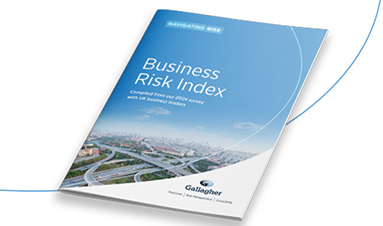An analysis of the most pressing concerns based on insights from 1,000 UK business leaders.

Evaluation and reporting of Environmental, Social and Corporate Governance (ESG) criteria is becoming increasingly important for Real Estate organisations – and as part of the ESG agenda, companies need to show how they will consider, manage, mitigate and protect themselves against a range of environmental risks.
An important component of ESG is that a company should have a strategy to ensure the sustainability of its business and have demonstrable measures in place to be resilient. In addition to increasing environmental and social performance, it can add value to a company and protect its financial performance.
In this article, we highlight some areas where Environmental Impairment Liability (EIL) insurance has a positive role to play in risk mitigation, protection of business and ultimately protection of the environment for the Real Estate sector.
How can Environmental Impairment Liability (EIL) insurance support ESG in Real Estate?
Traditionally, EIL has mainly been used in single property transactions, for insuring against potential claims and regulatory liabilities arising from pre-existing pollution conditions (historic contamination). Increasingly, however, real estate owners and investors are acquiring EIL to cover their operational risks and/or property portfolios.
Change is a constant, whether it is a change in law, new scientific discovery, new technology, increased awareness, or simply a change in who/what is next door. It is not just environmental risks themselves that change over time, but people’s perceptions as well, as we have seen. This makes the challenges of effective environmental risk management and protection even greater.
We have very briefly summarised below a range of environmental risks that real estate organisations should be considering. The list is certainly not exhaustive and each risk is worthy of an article in its own right:
- Climate change risk
- Emerging Contaminants
- Waste crime
- Historic contamination
- Site development pollution risks
- Operational pollution risks
- Knotweed & other invasive plants
- Asbestos
- Electro Magnetic Frequency (EMF)
- Radioactive substances
- Natural resource/biodiversity damage
- Legionella disease.
Landlord and landowners can face residual liability for pollution caused by their tenants and contractors (especially following insolvency of the polluter) and liability for pollution caused by trespassers and illegal occupants. There are a number of multi-million pound claims in the UK on landlords for this type of scenario ranging from individuals to blue chip pension funds.
Recently, we have seen a shift in clients’ focus (especially amongst Real Estate developers & investors) from onsite liabilities (clean-up costs, etc.) to realisation of the potential impact of offsite third party claims and the need to mitigate against them. In addition, landlords and investors are increasingly considering how an environmental claim may impact their tenants’ business’s operations in terms of shutting them down or delaying their operations, resulting in loss of rental income and third party business interruption claims.
Many of the risks listed above are insurable with a specific EIL policy, but the coverage available and cost is highly dependent on a range of factors, such as the quality and extent of technical information, structure of contracts, etc.
EIL can protect business operations from interruption caused by pollution/contamination and cover property investment income such as loss of rent, to protect landlords and lenders/investors. This can be combined with contingency plans showing a robust and demonstrable management and mitigation of risks.
Policies can cover Directors and Officers of insured parties, multiple insureds and their benefits can also be assigned to a new purchaser and investors. Cover can be obtained for ongoing commercial/industrial activities, thus protecting a company’s business operations and employment.
Reputational risk and the ability to respond proactively to an incident and effectively manage the ensuing communications and public relations issues can be an important factor for companies. Some policies can extend to include crisis management and emergency response costs.
EIL can also help to facilitate transactions and loans/investments, by transferring known and unknown environmental liability risks in an open and transparent way for a known cost to an environmental insurer. Thus showing management of the risk and adding value.
Summary
Ultimately, in the event of a significant environmental claim the company responsible (the ‘Polluter’) may become insolvent and be unable to pay, in which case the liability is likely to transfer to the landowner/landlord/employer.
Real Estate organisations are discovering that, irrespective of the contractual and technical risk mitigation measures they implement, not all risks can be ‘engineered out’ and some residual environmental risks will most likely remain with the site owner/operator, if the ‘polluter’ no longer exists.
With a combination of risk assessment planning and a properly structured EIL policy, stakeholders can be provided with protection to support both the sustainability of their business and protection of the environment.




